| BEFORE II W.W. | II W.W.
|
AFTER II W.W. |
| UPDATED MAR 2024 | ME - CONTACT |
 |
|
HAWKER TYPHOON - SMITH MK II B y D |
|
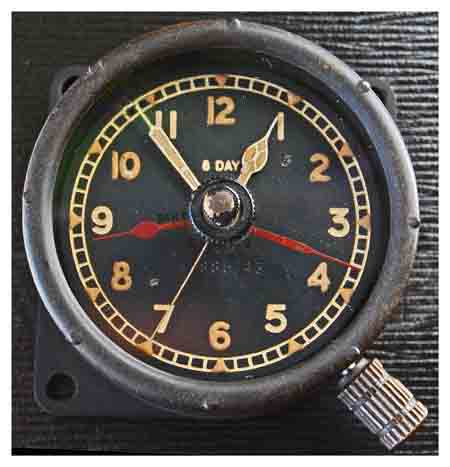 |
|
THE CLOCK The wartime need for quantity instead of quality is reflected in this clock, the manufacturer did not record anything on the movement, only on the dial. The machine is a copy of Jaeger LeCoultre 201 as shown in the photos below, this copy is of inferior quality than the MK II of Lancaster or Spitfire, the winding mechanism is different. It has 5 jewels and power for 8 days. Provides time and selecting with the red dummy hands the time at take off and then subtracting we have the flight time, it never fails.
|
|
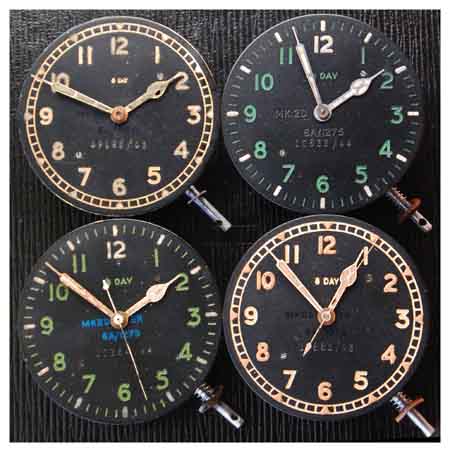 |
|
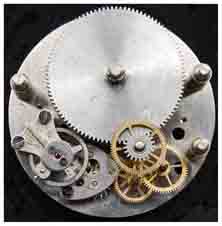 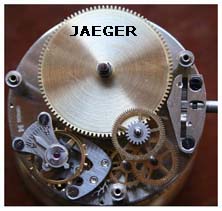 |
|
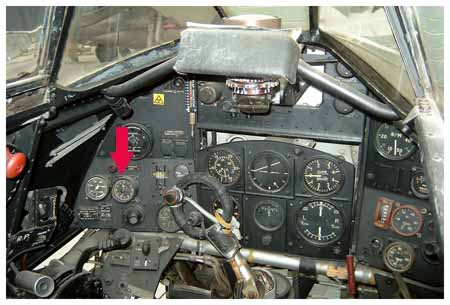 |
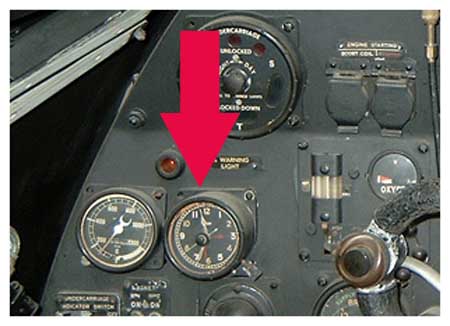 |
 |
THE PLANE 3.317 Typhoons were built but only one is left, it is in the RAF Museum at Hendom, the cockpit photo to the side is from this aircraft, and its indicated with an arrow where the clock was, the photo immediately above must be the Tempest´s cockpit (is the name given to the latest version of the Typhoon), the clock is MK II B. In the flight manual (Pilot notes) normally it said where the clock was situated, but not a description, however some book says it was the MK II D. We do not know exactly, but I think there were two. Born to replace the Hurricane in 1940, the Typhoon was built in mass due to the appearance of the Focke Wulf 190 (with was better than the Spitfire V), because the plane had many problems like, engine stops, unexplained accidents due to a failure in a lead block that served as weight compensation and it fell over elevator´s wire, leading to a violent dive that never ends well. Also for its resemblance to the FW 190 was the plane with more friendly fire casualties. The Typhoon as high altitude fighter was not good, but when he rode 120 kilos bombs, and later rockets, was found that it was very good plane, it was then used as low level tactical attack, its stability and power improved pilot´s aim, being lethal to the German surface forces, it was so effective than the Germans were forced to move men and equipment at night, restricting their ability to fight. THE COCKPIT The exhaust gases of the 24 cylinder engine filed the cockpit and pilots had to use oxygen mask before engine start, this problem never was sold. What was most striking was the cockpit hood, with side doors opened outwards, and side windows that one could wind down with car-door type handles and a glass that covering the top, they called coffin doors. The jettisoning was an odd operation, you had to cross your hands and grab rails both sides and pull inwards to open, then release the harnesses and remove the oxygen mask, put the airplane upside down and drop out, all flying at low altitude as they used to do was very likely to hit the ground The pilots preferred the forced landing than baling out they had much confidence for the many occasions when in a forced landing, the wing were lost, the tail too practically the plane was disappeared but the cockpit and the pilot remained intact due to the structure´s fortress and the thousand kilos of Napier engine ahead, it was able to cross houses without damage to the pilot. Later a bubble-shaped canopy was installed increasing the visibility. As in the Spifire, the throttle is on the left side and the landing gear on the right, which forced the pilots to change hands shortly after take off. The 2.500 horsepower torque was so great, that experts pilots in the Spitfire, became airborne 30 degrees right of the runway heading, unable to stop the aircraft swing and with the full left rudder in, the less experienced could swing more than 90 degrees. Taxing was complicated by the lack of forward visibility, to avoid accidents when taxing for take off several at a time a mechanic was rose in the wing, the mechanic was who sometime had the accident falling from the wing, it was not difficult. |
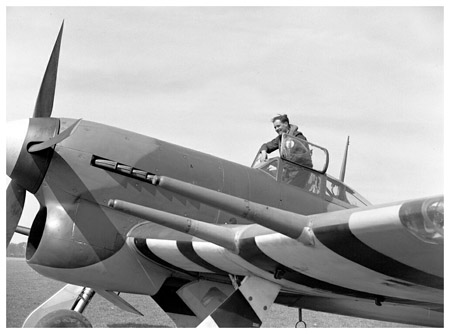 |
|
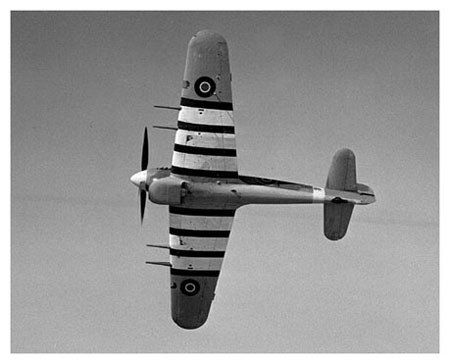 |
|
 |
|
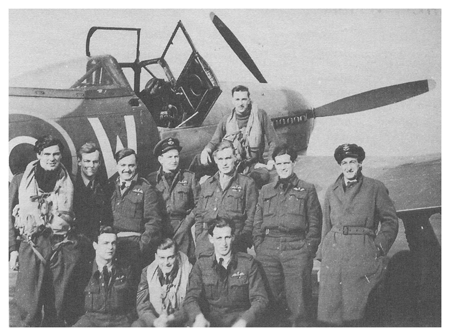 |
|
 |
|
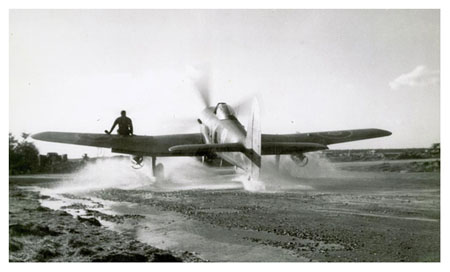 |
|
For FlyingOfficer W. Smith June 1944 was a month full of events. The day before D-Day on June 5 attacking a German radar settlement in Auderville, his Typhoon was hit by Flack (antiaircraft artillery), he managed to reach 7,000 feet before bailing out as his engine failed, he came down in the channel where he was rescued floating on his dinghy because its Flight Commander W. S. Reynolds remained in orbit above him and guided a Walrus hydroplane to pick him. He himself also had to baling out and was picked up by another Walrus. On June 10, on D+4, Smith went with 7 other Typhoons in a rocket attack to the headquarters of a Panzer Division, the fire was intense and was again reached, Wing Commander Charles Green instructed Smith to put the damaged aircraft down on one of the new strips, the one at Banville, called B-3, so he did a safe landing. When the plane stopped a swarm of photographers and senior officers welcomed him, and was informed that it was the first English pilot to land in France since D day, this honor had been reserved for Vice Marshall Harry Broadhurst who landed his Spitfire shortly afterwards, but already second. Smith breakfasted at a nearby village, collected a German helmet from a dead German soldier and when his Typhoon was patched up a couple of hours later, he flew home. From the book: Typhoon Attack by Norman Franks, very interesting and shocking book with stories of those who did not return. |
|
The Typhoon does not have famous Aces, but it gives us an idea of the hardness of the missions to have 666 pilots killed, with an average age of 22 years, and 169 prisoners, the nationalities of casualties were: United Kingdom 311, Canada 150, New Zealand 48, Australia 42, South Africa 19, Belgium 17. |
 |
The Typhoon had a great role in the invasion of Normandy, destroyed 82% of radar settlements in southwestern of France, these objectives were all well protected by the Flak and heavily fortified, Flack settlements ( were well camouflaged and some were mobile, Typhoons attack it in line flying in pairs, when the first was shot then the second saw were where the settlement and shoot the target, nothing more dangerous were made, one was the bait an the other the fishermen). They attacked settlements of the V-1 also very well protected, and they gave great support to surface forces, during the 10 days of the attack on Falaise 1.000 sorties was made each day. |
|
In 1990, it was inaugurated in Noyers-Bocage near Caen this monument to those killed in Typhoons during the Normandy Battle, engraved in marble is remembered and honored one by one the 151 pilots killed. I want to honor and to have a live remember of this braves: |
 |
 |
|
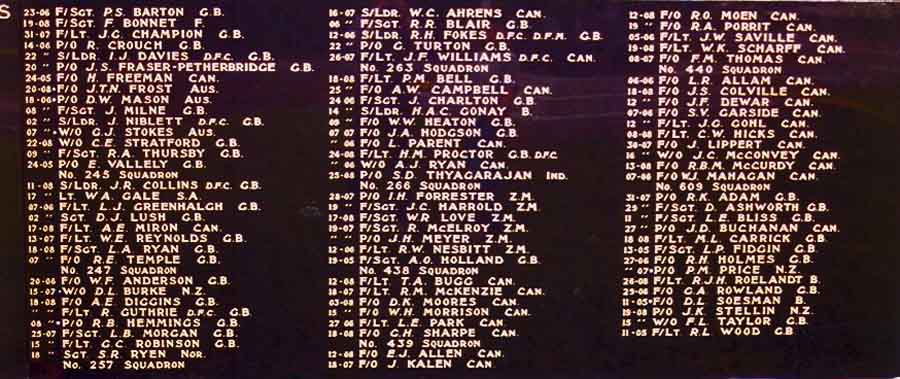 |
|
GO TO - CLOCKS FOR SALE |
GO TOP OF THE PAGE |
HOME |